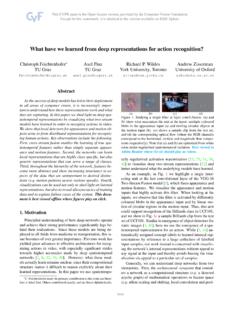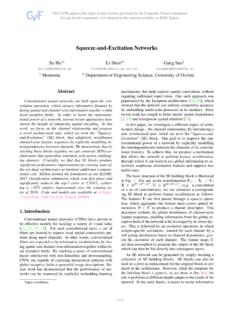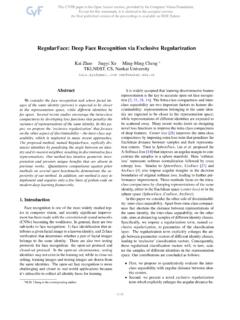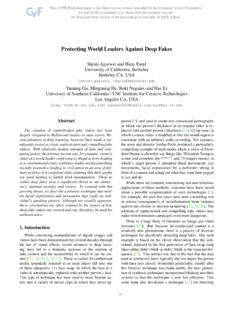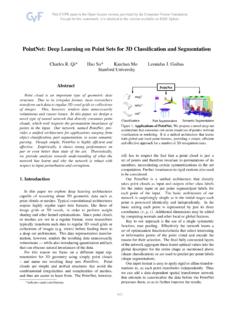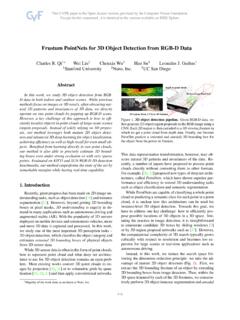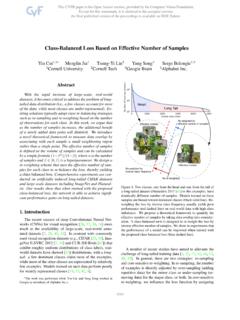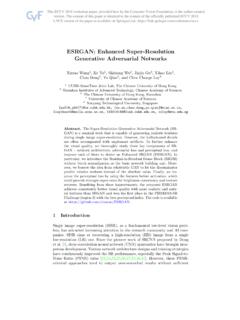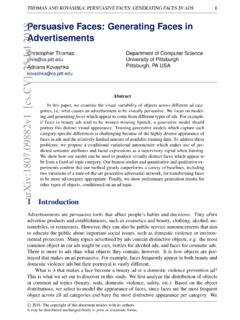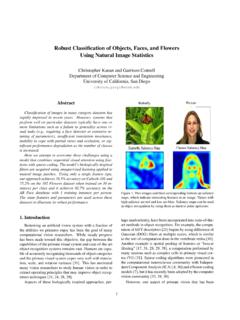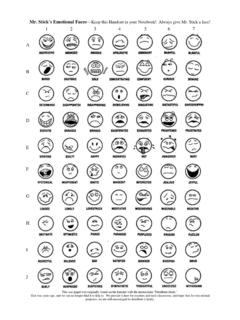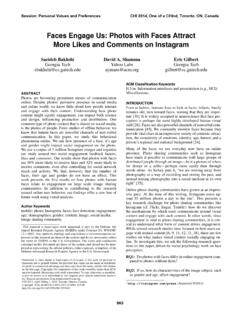Transcription of Finding Tiny Faces in the Wild With Generative Adversarial ...
1 Finding Tiny Faces in the Wild with Generative Adversarial NetworkYancheng Bai1,3 Yongqiang Zhang1,2 Mingli Ding2 Bernard Ghanem11 Visual Computing Center, King Abdullah University of Science and Technology (KAUST)2 School of Electrical Engineering and Automation, Harbin Institute of Technology (HIT)3 Institute of Software, Chinese Academy of Sciences The detection results of tiny Faces in the wild. (a) is the original low-resolution blurry face, (b) is the result ofre-sizing directly by a bi-linear kernel, (c) is the generated image by the super-resolution method, and our result (d) is learnedby the super-resolution ( 4 upscaling) and refinement network simultaneously.
2 Best viewed in color and zoomed detection techniques have been developed fordecades, and one of remaining open challenges is detect-ing small Faces in unconstrained conditions. The reason isthat tiny Faces are often lacking detailed information andblurring. In this paper, we proposed an algorithm to direct-ly generate a clear high-resolution face from a blurry smallone by adopting a Generative Adversarial network (GAN).Toward this end, the basic GAN formulation achieves it bysuper-resolving and refining sequentially ( SR-GAN andcycle-GAN). However, we design a novel network to addressthe problem of super-resolving and refining jointly.
3 We alsointroduce new training losses to guide the generator net-work to recover fine details and to promote the discrimina-tor network to distinguish realvs. fake and facevs. non-facesimultaneously. Extensive experiments on the challengingdataset WIDER FACE demonstrate the effectiveness of ourproposed method in restoring a clear high-resolution facefrom a blurry small one, and show that the detection perfor-mance outperforms other state-of-the-art IntroductionFace detection is a fundamental and important prob-lem in computer vision, since it is usually a key step to-wards many subsequent face-related applications, includingface parsing, face verification, face tagging and retrieval,etc.
4 Face detection has been widely studied over the pastfew decades and numerous accurate and efficient methodshave been proposed for most constrained scenarios. Recen-21t works focus on Faces in uncontrolled settings, which ismuch more challenging due to the significant variations inscale, blur, pose, expressions and illumination. A thoroughsurvey on face detection methods can be found in [32].Modern face detectors have achieved impressive resultson the large and medium Faces , however, the performanceon small Faces is far from satisfactory. The main difficul-ty for small face ( 10pixels) detection is that s-mall Faces lack sufficient detailed information to distinguishthem from the similar background, regions of partialfaces or hands.
5 Another problem is that modern CNN-basedface detectors use the down-sampled convolutional (con-v) feature maps with stride 8, 16 or 32 to represent Faces ,which lose most spatial information and are too coarse todescribe small Faces . To detect small Faces , [28] directlyup-samples images using bi-linear operation and exhaus-tively searches Faces on the up-sampled images. Howev-er, this method will increase the computation cost and theinference time will increase significantly too. Moreover,images are often zoomed in with a small upscaling factors(2 at most) in [28], otherwise, artifacts will be generat-ed. Besides, [1,14,25,37] use the intermediateconvfea-ture maps to represent Faces at specific scales, which keepsthe balance between the computation burden and the perfor-mance.
6 However, the shallow but fine-grained intermediateconvfeature maps lack discrimination, which causes manyfalse positive results. More importantly, these methods takeno care of other challenges, like blur and deal with the nuisances in face detection, we proposea unified end-to-end convolutional neural network for betterface detection based on the classical Generative adversarialnetwork (GAN) framework. There are two sub-networks inour detector, a generator network and a discriminator net-work. In the generator sub-network, a super-resolution net-work (SRN) is used to up-sample small Faces to a fine scalefor Finding those tiny Faces .
7 Compared to re-sizing by bi-linear operation, SRN can reduce the artifact and improvethe quality of up-sampled images with a large upscaling fac-tors (4 in our current implementation), as shown in Figure1 (b) and (c). However, even with such sophisticated S-RN, up-sampled images are unsatisfactory (usually blurringand lacking fine details) due to Faces of very low resolutions(10 10pixels). Therefore, a refinement network (RN) isproposed to recover some missing details in the up-sampledimages and generate sharp high-resolution images for clas-sification. In the discriminator sub-network, we introduce anew loss function that enforces the discriminator network todistinguish the real/fake face and face/non-face simultane-ously.
8 The generated images and real images pass throughthe discriminator network to JOINTLY distinguish whetherthey are real images or generated high-resolution imagesand whether they are Faces or non- Faces . More important-ly, the classification loss is used to guide the generator togenerate clearer Faces for easier sum up, this paper makes followingthree main contributions.(1)A novel unified end-to-endconvolutional neural network architecture for face detectionis proposed, where super-resolution and refinement networkare used to generate real and sharp high-resolution imagesand a discriminator network is introduced to classify facesvs.
9 Non- Faces .(2)A new loss is introduced to promote thediscriminator network to distinguish the real/fake image andface/non-face simultaneously. More importantly, the clas-sification loss is used to guide the Generative network togenerate clearer Faces for easier classification.(3)Finally,we demonstrate the effectiveness of our proposed methodin restoring a clear high-resolution face from a blurry smallface, and show that the detection performance outperform-s other state-of-the-art approaches on the WIDER FACE dataset, especially on the most challenging Hard Related Face DetectionAs a classic topic, numerous face detection systems havebeen proposed during the past decades or so.
10 Existingface detection methods can be broadly categorized as hand-crafted feature based methods [24,29,30] and CNN-basedmethods [34,2,14,25,37,1]. However, most of the de-tection systems based handcrafted features only train a sin-gle scale model, which is applied to each level of a featurepyramid, thus increasing the computation cost drastically,especially for complicated features. Moreover, the limitedrepresentation of handcrafted features restricts the perfor-mance of detectors, particularly in uncontrolled by the great success of Faster RCNN, severalrecent works [14,25,37] utilized this framework to detec-t Faces and showed impressive performance on the FDDB benchmark [13].
